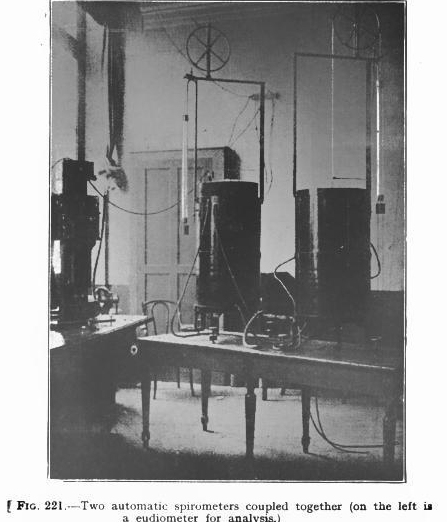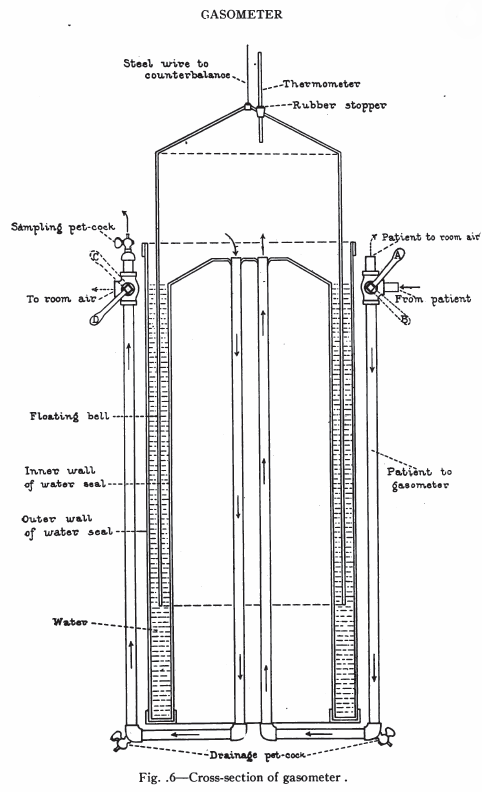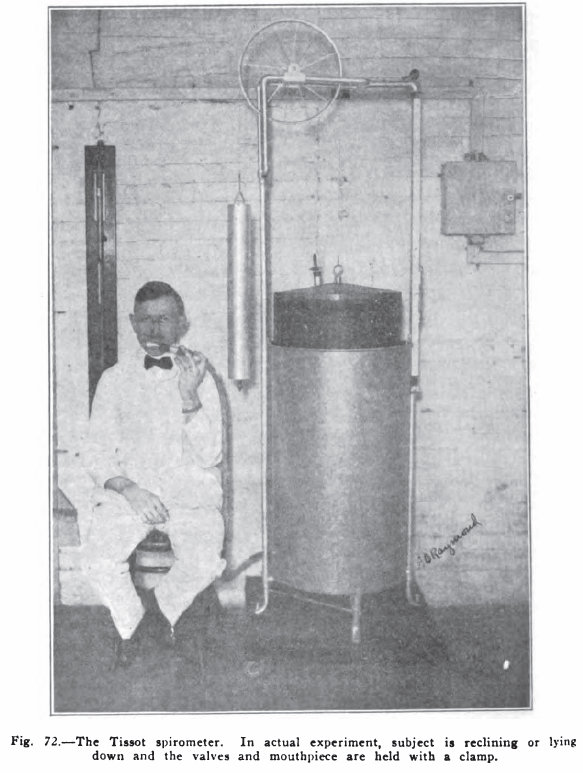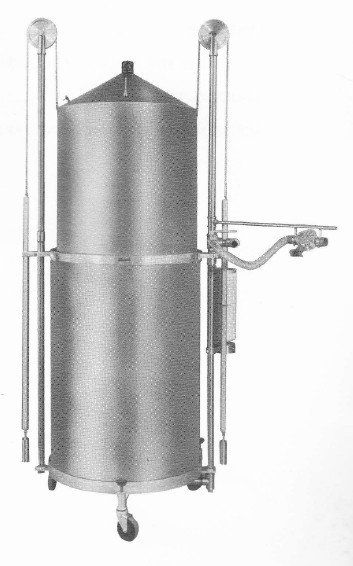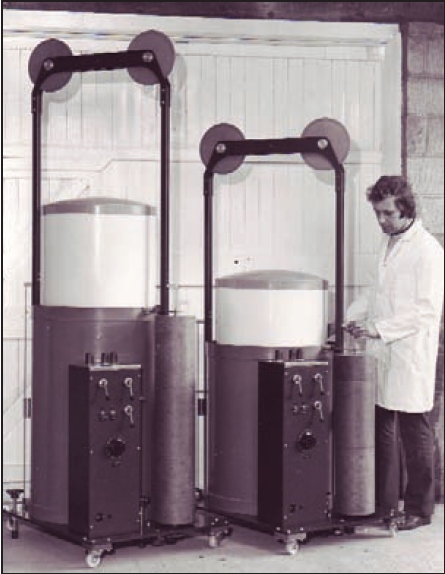Tissot developed an exceedingly large water-seal spirometer in 1904. This design was critical to the development of many forms of Exercise, Metabolic and Pulmonary Function testing. They continued to be manufactured up until the 1980’s.
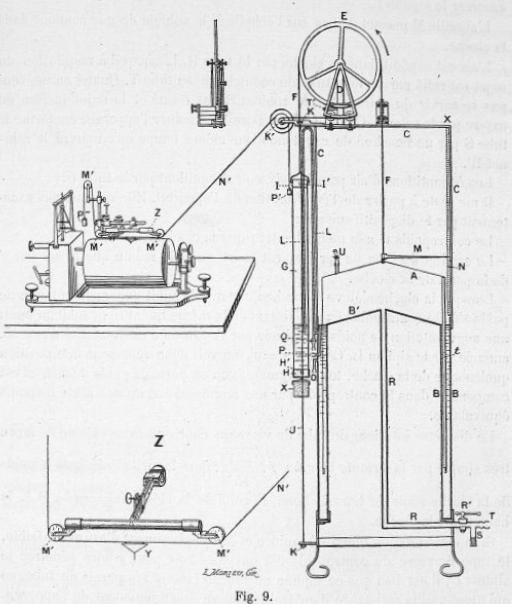
Tissot Spirometer, 1904. First published description of the Tissot Spirometer. From J. Tissot, “Nouvelle méthode de mesure et d’inscription du débit et des mouvements respiratoires de l’homme et des animaux”, Journal de physiologie et de pathologie générale, 1904, vol 6, pp. 693
Tissot Spirometers, circa 1910. From “The Human Motor”, author and date of publication unknown, page 313.
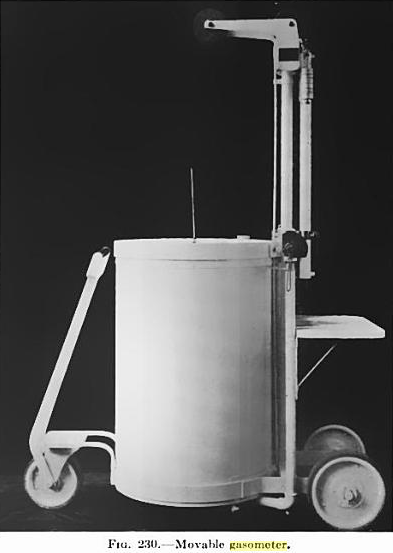
Portable Tissot Spirometer, 1919. From: Collected Papers of the Mayo Clinic and the Mayo Foundation: 1919, Volume 11, page 494.
Tissot Spirometer Diagram, 1920. From: Laboratory Manual of the Technic of Basal Metabolic Rate Determinations, Walter Meredith Boothby, Irene Sandiford, published 1920 W.B. Saunders. Page 43
Tissot spirometer, 1920. From: The Newer Methods of Blood and Urine Chemistry, by By Rutherford Birchard Hayes Gradwohl, Abraham Jacob Blaivas, 1920, Page 372.
“The Tissot Spirometer is shown in figure 72. We have found the 100 liter size to be very serviceable in the clinic. This instrument is mounted on a platform having rubber wheels, and can be moved about the wards with ease. The bell of the spirometer is made of aluminum and is suspended in a water-bath between the double walls of a hollow cylinder made of galvanized iron. The height of the bell is 72 cm and the diameter is 42 cm. An opening at the bottom of the cylinder connects through a three-way stopcock with the rubber tube leading from the expiratory valve of the mouthpiece. The bell is counterpoised by means of a weight. In the original Tissot spirometer an automatic adjustment permitted water in amount equal to the water displaced by the bell to flow into a counterpoise cylinder as the bell ascended out of the water. The bell, being heavier out of the water than when immersed, is accordingly counterpoised in any position, although Carpenter has shown that this refinement is unnecessary. An opening at the top of the spirometer permits the insertion of a rubber stopper, through which are passed a thermometer, a water manometer, and a stopcock with a tube for drawing the sample of air. The scale on the side of the instrument gives the volume of air.
“During an observation the subject sits in a reclining position or lies on a couch. When the bell of the spirometer is placed at zero, the mouthpiece adjusted in the mouth, and the nose clamped, respiration is started, the expirations passed through the stopcock, which is turned so as to allow them to pass to the outside air. After a few minutes the stopcock is turned so that the expirations are passed into the spirometer for a definite length of time. At the end of the period the cock is again turned, and after the barometric pressure, temperature, and volume of the gas has been noted, the composition of air is determined in the Haldane gas analysis apparatus.”
Tissot Spirometer Calibration, 1920. From: The calibration and accuracy of gas meters. By August Krogh. Biochemical Journal, 1920, Chapter XXIX, page 19.
“The calibration spirometer (fig 1) is an adaptation of a similar instrument employed by the Dannsk Maalerfabrik, the chief improvement being that I have arranged an automatic record of the volume per revolution of the meter calibrated. The drum (1) which is as nearly as possible cylindrical is suspended by a band of soft steel and counterbalanced by the adjustable weight (2). It moves up and down with a minimum of friction. When the drum is in its highest position the weight can be held by an electromagnet (not shown in the figure) from which it can be released at any desired moment by breaking the current. Along the steel band a fine brass wire is arranged carrying a number of lead weights (3). These can be displaced along the wire and a complete equilibrium in all positions of the drum can thus be secured. When the weight (2) is reduced, any desired pressure up to 20 mm. water can be produced in the spirometer. The revolving fan (4) which can be driven from outside is used for mixing purposes. In calibration work with air it is revolved for a few minutes when the spirometer has been filled, to secure a uniform temperature and perfect saturation of the air with water vapour.
“The drum is painted inside and out with a hydrophobe compound so that its volume will not be altered by water absorbed to its wall. This detail is very important. When left in contact with water, ordinary paint will take up a considerable volume of water which cannot drain off. According to experiments a painted tinplate continued to gain in weight while immersed in water for a couple of months, ultimately to the extent of 2.5 gm per 100 sq. cm. Such an increase would in my spirometer diminish by 3.5 cc the effective volume per cm.
“The spirometer drum has been calibrated by measuring a large number of internal diameters (133) evenly distributed over the whole length and circumference of the drum. These measurements have given as the average diameter 450..135 +/- 0.09 mm or a volume of 1591.4 cc per cm. height. When the drum is used in the spirometer a lowering of 1 cm. will drive out a little more air than the corresponding volume of the drum because the surface of the water in the reservoir will be raised when 1 cm. of wall of the the drum is lowered into it. The volume of 1 cm. of the wall of the drum is 9.4 cc. The rise in the water level will of, course, correspond to 9.4 cm., but since only 19.0% of the water surface is inside the drum the extra volume corresponding to 1 cm. will be 19/100 x 9.4 = 1.8 cc and the effective volume of 1 cm. is therefore 1593.2 cc. A further correction for the volume of the hydrophobic paint and for water adhering to the inside reduced the volume to 1593.0 cc. This latter correction is of course a little arbitrary. When the drum has been rapidly raised the water must be allowed to drain off for about 5 minutes before a practically constant volume is attained. The water adhering to it at first may amount to a couple of cc. per cm. or more.”

Collins Tissot Gasometer, 1922. Found in Surgery, Gynecology and Obstetrics, Volume 35, December 1922, page 16.
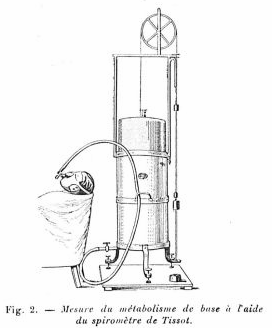
Tissot Spirometer, 1927. Being used for basal metabolism. From La Presse Medical, 1927, no. 76, page 1146.
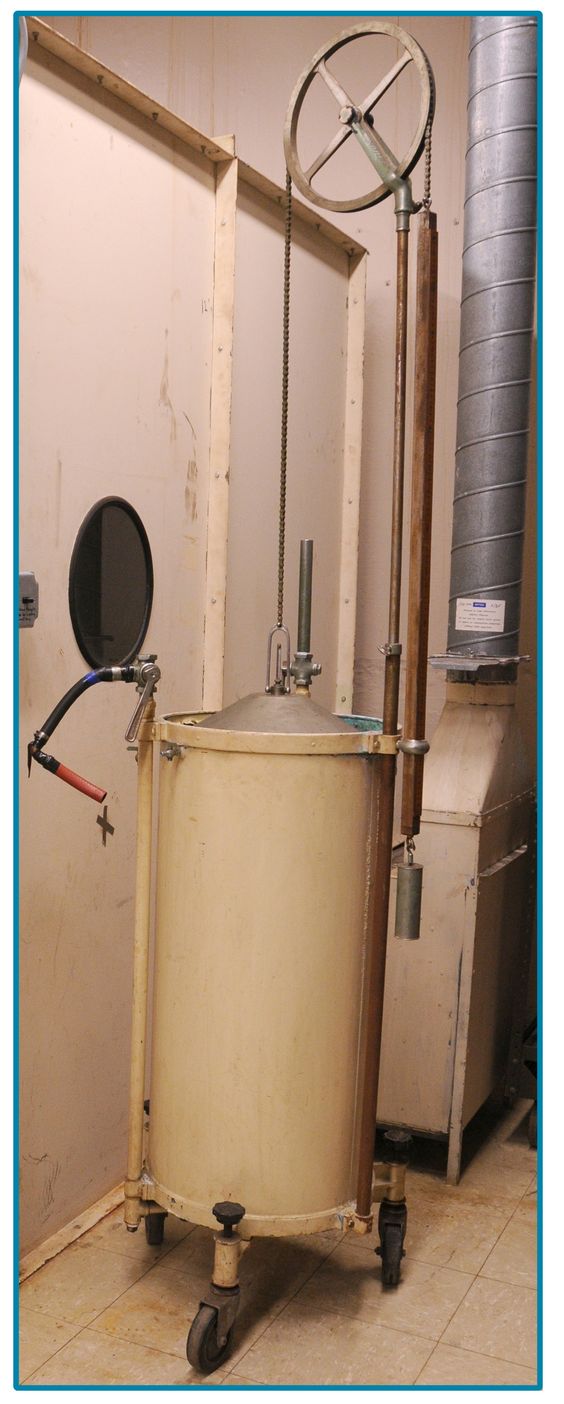
Tissot Spirometer, circa 1930. The age and manufacturer are unknown but the design is similar to Tissot spirometers manufactured between 1920 and 1950. Found on Pinterest.
Tissot Spirometer, 1945. From Bioenergetics and Grown by Samuel Brody, Published by Reinhold Publishing, NY, 1945. Chapter 12, page 337. Found on the website BeefEfficiency.org.
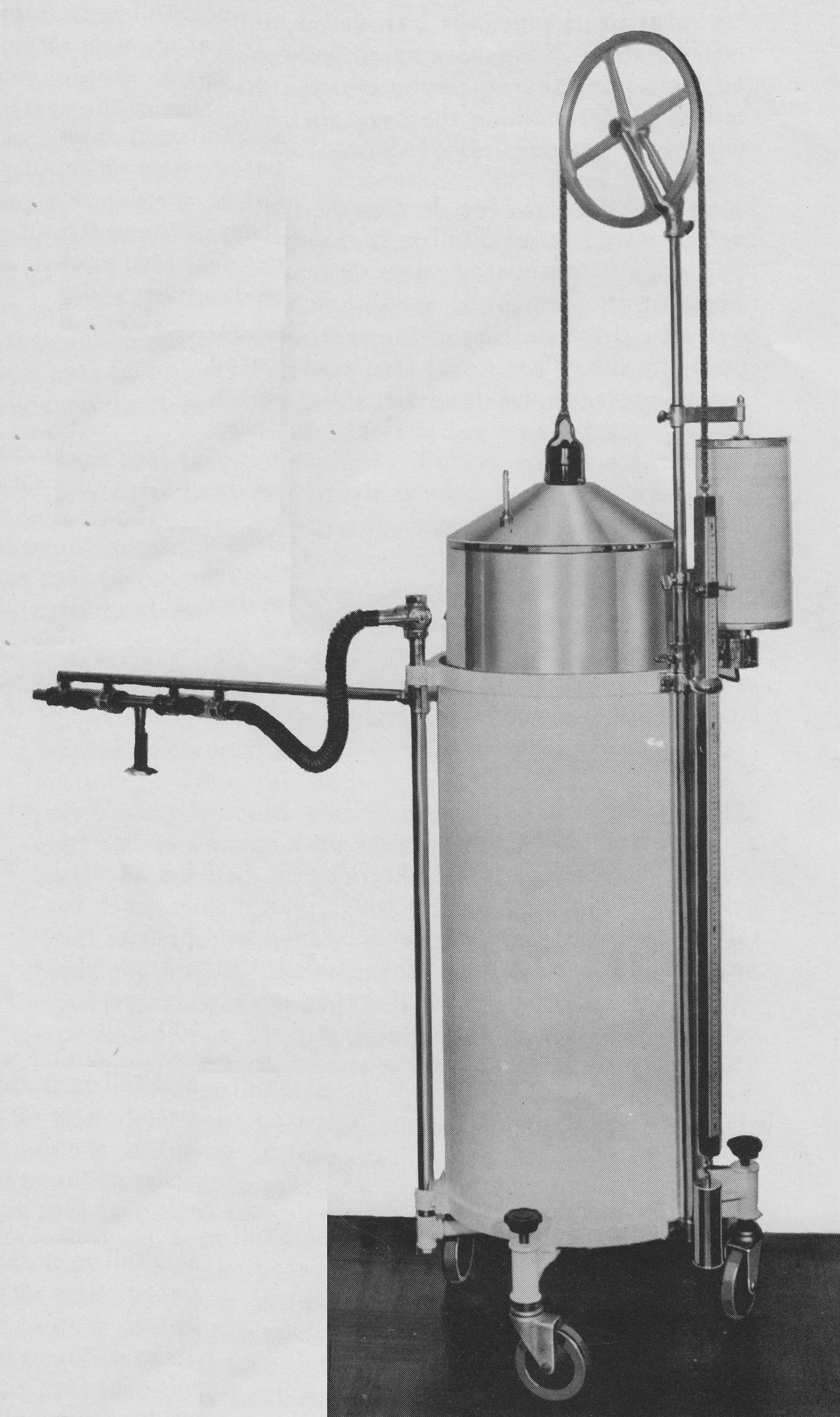
Tissot Spirometer, Collins, 1948. From a sales brochure.
Tissot Spirometer, probably manufactured before 1950. From: http://www.cphr.fr/wp-content/uploads/2013/04/Spirometre-tissot_2011.64.pdf
120 Liter Godart Tissot Gasometer, 1967. From Medical Electronic Laboratory Equipment 1967-68: Pergamon Electronics Data Series by G. W. A. Dummer, J. Mackenzie Robertson, published by Elsevier, page 579.
120 Liter and 350 Liter Collins Tissot Gasometer, 1967. From “Directions for operating a Collins chain-compensated gasometer”, Second Edition Cat. No. P-469. Warren E. Collins, Inc. May, 1967.
“PRINCIPLE OF CONSTRUCTION
“The Gasometer is made of stainless steel with an outer body and an inner body space about two inches apart to form a water seal for the Spirometer bell fo “float” in. The inner body is also shapes to occlude most of the dead space; and the whole unit is mobile on its own casters.
“CHAIN COMPENSATION
“When the Gasometer is filled with water to the petcock level, and the Spirometer bell is in its lowest position, the bells weighs less than when it is in its highest position, because of the buoyant effect of the water. To automatically compensate for this increasing weight so that the bell will be perfectly counterbalanced throughout its travel, the Collins Gasometer uses a chain to connect the bell to the main counterweight. Thus, as the bell rises, more segments of chain pass over the pulley. As the bell becomes heavier, so does the counterweight in direct proportion, with the result that almost perfect balance is achieved in all positions.
“ATTACHMENTS
“The Gasometer is fitted with the following standard attachments:
“Thermometer – indicates the temperature of the gas within the bell to facilitate various gas volume calculations.
“Auxillary Counterweight – removable so that the Spirometer maybe emptied quickly bu gravity.
“Two-Way Valve – permits addition or subtraction of gas while the patient is breathing. May also be used for sampling.”
Adjustable Height Knob – 120 Liter model: permits telescoping of the chain and pulley downwards. 350 and 600 liter models: pulley supports unscrew. Facilitates transportation and permits moving through low doorways.
“Leveling Screws – assures vertical position of the Spirometer so that the bell will not contact the side of the outer body.
Breathing Branch Assembly – supplies with the 120 liter Gasometer only. It serves as a support for the J-2 Valve or other breathing valves and tubing when the patient is to breathe directly into the Spirometer either from a sitting position or from the bedside.”
Tissot Spirometers, 1970’s. Probably made by Godart. Image from Mr. Kevin Hogben International Sales and Product Specialist Manager for Medisoft
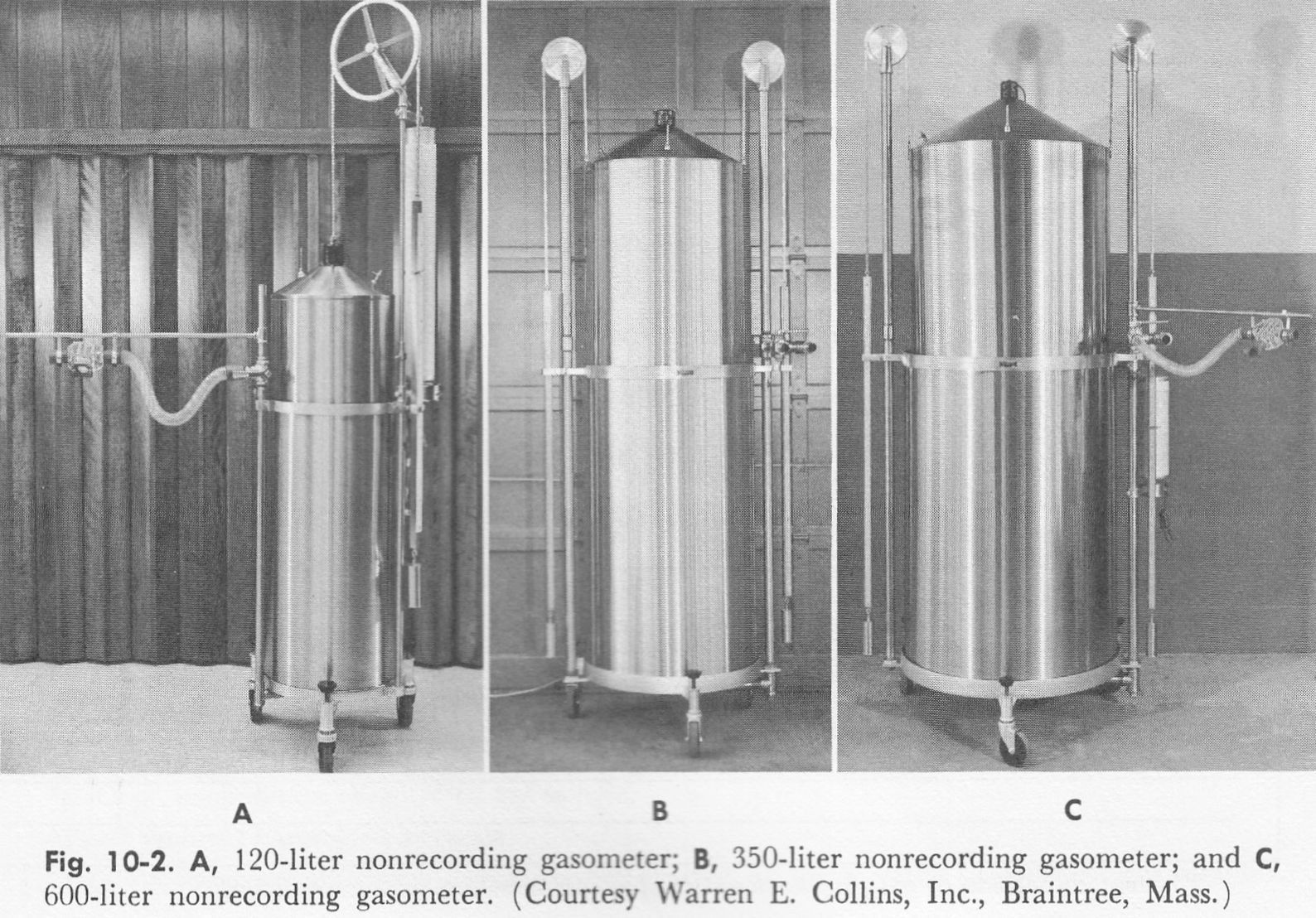
Tissot Spirometers, Collins, 1972. From “Laboratory manual for physiology of exercise”, by Laurence E. Morehours, Published by C.V. Mosby, 1972, page 87.
A Collins 120 liter Tissot spirometer. Probably manufactured in the 1970’s or 1980’s. Shown empty and partially filled. Found in the course material for an exercise physiology class on a shared university website.

PFT History by Richard Johnston is licensed under a Creative Commons Attribution-NonCommercial 4.0 International License.
